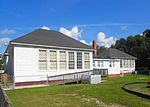Cape May County is the southernmost county in the U.S. state of New Jersey. Much of the county is located on the Cape May peninsula, bound by the Delaware Bay to its west and the Atlantic Ocean to its south and east. Adjacent to the Atlantic coastline are five barrier islands that have been built up as seaside resorts. A consistently popular summer destination with 30 miles (48 km) of beaches, Cape May County attracts vacationers from New Jersey and surrounding states, with the summer population exceeding 750,000. Tourism generates annual revenues of about $6.6 billion as of 2018, making it the county's single largest industry. The associated leisure and hospitality industries are Cape May's largest employers. Its county seat is the Cape May Court House section of Middle Township. The county is part of the Jersey Shore region of the state.
As of the 2020 census, the county was the state's second-least populous county, with a population of 95,263, a decrease of 2,002 (−2.1%) from the 2010 census count of 97,265, which in turn reflected a decline of 5,061 (-4.9%) from the 102,326 counted in the 2000 census. The county is part of the Ocean City, NJ metropolitan statistical area and the Philadelphia-Reading-Camden, PA-NJ-DE-MD combined statistical area, also known as the Delaware Valley.Before Cape May County was settled by Europeans, the Kechemeche tribe of the Lenape Native Americans inhabited South Jersey. Beginning in 1609, European explorers purchased land from, and contributed to the decline of, the indigenous people. The county was named for Cornelius Jacobsen Mey, a Dutch captain who explored and charted the area from 1620 to 1621, and established a claim for the province of New Netherland. In 1685, the court of Cape May County was split from neighboring Burlington County, although the boundaries were not set until seven years later. In 1690, Cape May (originally known as Cape Island) was founded, becoming America's oldest seaside resort.
The county was subdivided into three townships in 1798: Lower, Middle, and Upper. The other 16 municipalities in the county, including two no longer in existence, were established between 1827 and 1928. In 1863, the first railroad in the county opened, which carried crops from the dominant farming industry. Railroads later led to the popularity of the county's coastal resorts. The need for improved automotive access to the county led to the development of the Garden State Parkway, which opened in 1956.
The most populous place was Lower Township with 22,057 residents in the 2020 census, and its geographically largest municipality is Middle Township, which covers 82.96 square miles (214.9 km2).











